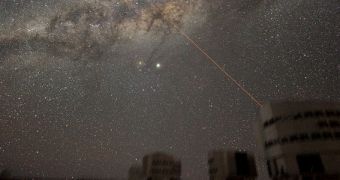A group of investigators from the US National Institute of Standards and Technology (NIST), led by physicist Gillian Nave, were recently able to improve and update an existing imaging technology for use in astronomy. The team argues that their approach can be used to detect signs of extrasolar data in old datasets spanning back several decades.
In addition to browsing older datasets, the new approach can be used to improve the sensibility and detection capabilities of existing telescopes. Exoplanets are extremely difficult to identify and confirm, regardless of the method used to track them down. Even worse is the fact that potentially habitable alien worlds that orbit in the habitable zones of their parent stars are usually too dim to notice.
Whatever light they do reflect usually gets lost in the glare their parent stars impress upon telescope detectors. However, planets also have the tendency to make their stars wobble a bit on their axis due to the gravitational pull they exert on the larger objects. Modern telescopes such as NASA's Kepler are very good at detecting these slight variations.
NIST physicists say that the same gravitational tugs that cause the wobbles also have an interesting effect on the light released by the stars. In essence, colors vary slightly due to the Doppler effect, and this can be gaged using specialized spectral analysis. An unchanging spectrum is used as reference and the incoming starlight is separated into thin spectral lines. The two systems are then compared.
“It's like holding one ruler in front of another and moving the front one to the right and left. You can see the front ruler move compared to the one behind it. The star's spectrum is the front ruler, which moves as the planet tugs at it. But the movement is so small that to see it clearly, we need to put a fixed ruler of very high quality behind it. That's where NIST comes in,” Nave explains.
In this study, the research group conducted new measurements of the heavy element thorium, which is used in emission lamps to provide the aforementioned fixed ruler. This data could help astronomers identify a stellar system similar to our own. More than 400 exoplanets have been identified to date using the Doppler effect, but none of them is similar to Earth.
“Earth causes the Sun to move at a snail's pace. We don't yet have techniques that can find planets of that size, but our new data will get us much closer,” Nave goes on to say. He conducted the work with NOST postdoctoral fellow Stephen Redman and NIST physicist Craig Sansonetti. The last time thorium measurements were updated before this study was in 1983.
Previously, some 8,000 thorium spectral lines were known, but the new study boosted that number to nearly 20,000 lines. This is a nearly threefold improvement over previous values and an increase likely to contribute to identifying new exoplanets even in older datasets.
“We've already had astronomers from several telescopes ask if they could use the data for planet hunting. With luck, the measurements will help us search for planets near stars whose wobbling has been hard to detect,” Nave concludes.

 14 DAY TRIAL //
14 DAY TRIAL //